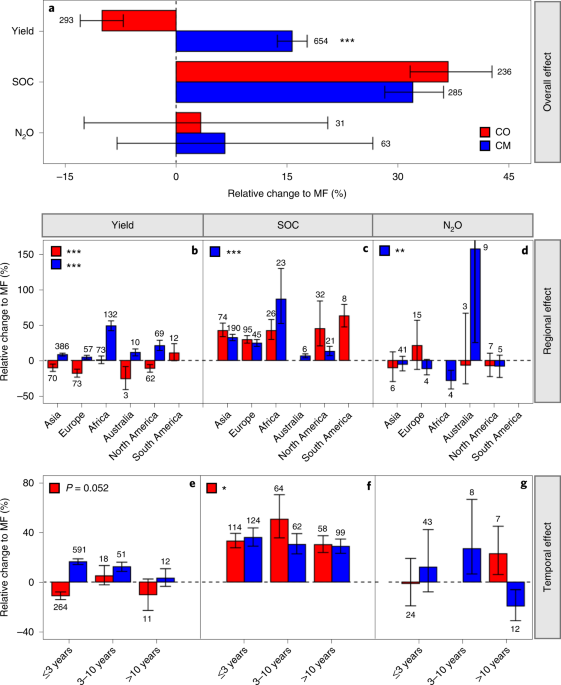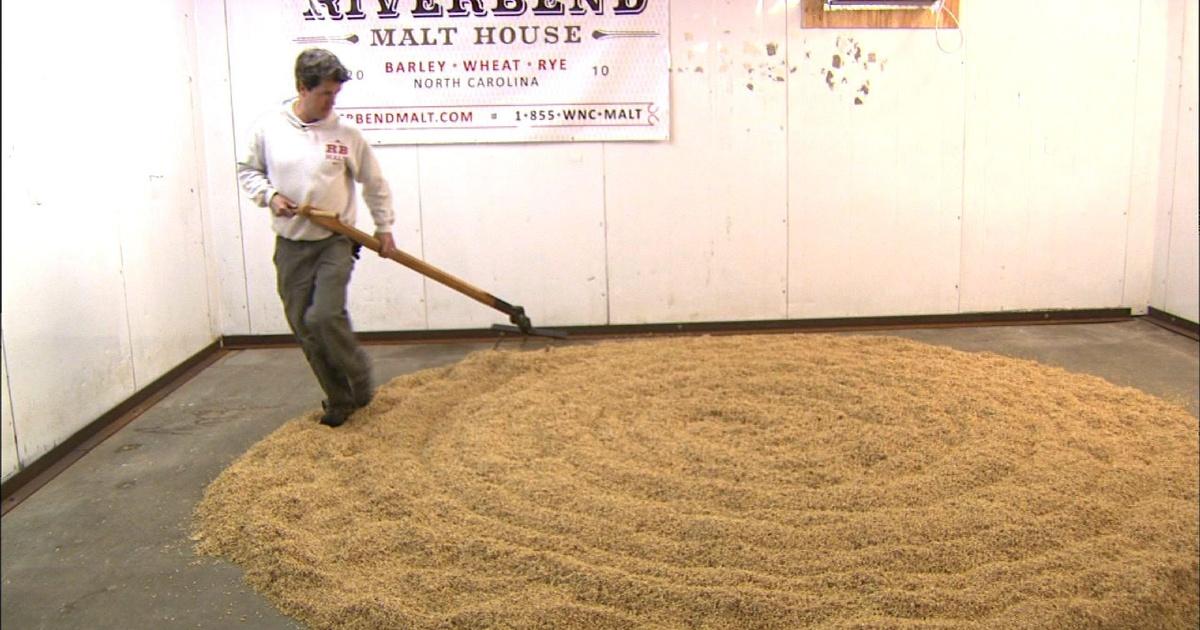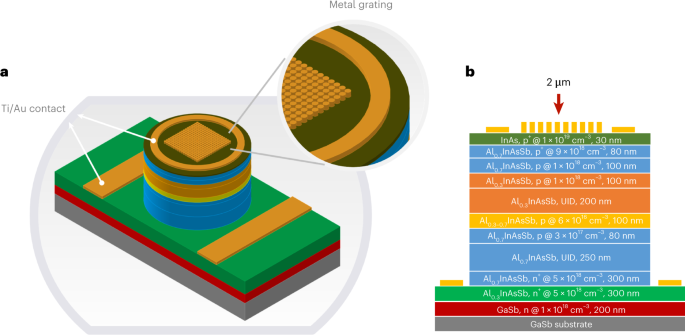
- Select a language for the TTS:
- UK English Female
- UK English Male
- US English Female
- US English Male
- Australian Female
- Australian Male
- Language selected: (auto detect) - EN
Play all audios:
ABSTRACT Compost represents an important input for sustainable agriculture, but the use of diverse compost types causes uncertain outcomes. Here we performed a global meta-analysis with over
2,000 observations to determine whether a precision compost strategy (PCS) that aligns suitable composts and application methods with target crops and growth environments can advance
sustainable food production. Eleven key predictors of compost (carbon-to-nutrient ratios, pH and salt content electric conductivity), management (nitrogen N supply) and biophysical settings
(crop type, soil texture, soil organic carbon, pH, temperature and rainfall) determined 80% of the effect on crop yield, soil organic carbon and nitrous oxide emissions. The benefits of a
PCS are more pronounced in drier and warmer climates and soils with acidic pH and sandy or clay texture, achieving up to 40% higher crop yield than conventional practices. Using a
data-driven approach, we estimate that a global PCS can increase the production of major cereal crops by 96.3 Tg annually, which is 4% of current production. A global PCS has the
technological potential to restore 19.5 Pg carbon in cropland topsoil (0–20 cm), equivalent to 26.5% of current topsoil soil organic carbon stocks. Together, this points to a central role of
PCS in current and emerging agriculture. Access through your institution Buy or subscribe This is a preview of subscription content, access via your institution ACCESS OPTIONS Access
through your institution Access Nature and 54 other Nature Portfolio journals Get Nature+, our best-value online-access subscription $29.99 / 30 days cancel any time Learn more Subscribe to
this journal Receive 12 digital issues and online access to articles $119.00 per year only $9.92 per issue Learn more Buy this article * Purchase on SpringerLink * Instant access to full
article PDF Buy now Prices may be subject to local taxes which are calculated during checkout ADDITIONAL ACCESS OPTIONS: * Log in * Learn about institutional subscriptions * Read our FAQs *
Contact customer support SIMILAR CONTENT BEING VIEWED BY OTHERS ORGANIC CROPPING SYSTEMS BALANCE ENVIRONMENTAL IMPACTS AND AGRICULTURAL PRODUCTION Article Open access 26 October 2024 AN
AGROECOLOGICAL STRUCTURE MODEL OF COMPOST—SOIL—PLANT INTERACTIONS FOR SUSTAINABLE ORGANIC FARMING Article Open access 31 March 2023 GLOBAL CROP PRODUCTION INCREASE BY SOIL ORGANIC CARBON
Article 30 October 2023 DATA AVAILABILITY The global compost effects observation dataset compiled for this study is available in Supplementary Data 1. The global input gridded datasets of
climate, soils and fertilization are publicly available and presented in Supplementary Table 11. Source data are provided with this paper. All other data that support the findings of this
study are available from the corresponding author upon reasonable request. CODE AVAILABILITY All codes developed for the BRT and RF analyses and to generate results are available from the
corresponding author upon request. REFERENCES * Zhang, X. et al. Quantification of global and national nitrogen budgets for crop production. _Nat. Food_ 2, 529–540 (2021). Article Google
Scholar * Oldfield, E. E., Bradford, M. A. & Wood, S. A. Global meta-analysis of the relationship between soil organic matter and crop yields. _Soil_ 5, 15–32 (2019). Article CAS ADS
Google Scholar * Rockström, J. et al. A safe operating space for humanity. _Nature_ 461, 472–475 (2009). Article PubMed ADS CAS Google Scholar * Crippa, M. et al. Food systems are
responsible for a third of global anthropogenic GHG emissions. _Nat. Food_ 2, 1–12 (2021). Article CAS Google Scholar * Sanderman, J., Hengl, T. & Fiske, G. J. Soil carbon debt of
12000 years of human land use. _Proc. Natl Acad. Sci. USA_ 114, 9575–9580 (2017). Article CAS PubMed PubMed Central ADS Google Scholar * FAO & ITPS. _The Status of the World’s Soil
Resources (SWSR)—Main Report_ http://www.fao.org/3/i5199e/i5199e.pdf (FAO, 2015). * Pergola, M. et al. Composting: the way for a sustainable agriculture. _Appl. Soil Ecol._ 123, 744–750
(2018). Article Google Scholar * Bernal, M. P. et al. Current approaches and future trends in compost quality criteria for agronomic, environmental, and human health benefits. _Adv.
Agron._ 144, 143–233 (2017). Article Google Scholar * Griggs, D., Stafford-Smith, M., Gaffney, O. & Noble, I. Sustainable development goals for people and planet. _Nature_ 495, 305–307
(2013). Article CAS PubMed ADS Google Scholar * Muir, J. P., Butler, T., Helton, T. J. & McFarland, M. L. Dairy manure compost application rate and timing influence bermudagrass
yield and nutrient concentration. _Crop Sci._ 50, 2133–2139 (2010). Article Google Scholar * Butler, T. J., Weindorf, D. C., Han, K. J. & Muir, J. P. Dairy manure compost quality
effects on corn silage and soil properties. _Compost Sci. Util._ 17, 18–24 (2009). Article Google Scholar * Cooperband, L., Bollero, G. & Coale, F. Effect of poultry litter and
composts on soil nitrogen and phosphorus availability and corn production. _Nutr. Cycl. Agroecosyst._ 62, 185–194 (2002). Article CAS Google Scholar * Ribas-Agustí, A. et al. Municipal
solid waste composting: application as a tomato fertilizer and its effect on crop yield, fruit quality and phenolic content. _Renew. Agr. Food Syst._ 32, 358–365 (2016). Article Google
Scholar * Rosa, D. D. et al. Effect of organic and mineral N fertilizers on N2O emissions from an intensive vegetable rotation. _Biol. Fertil. Soils_ 52, 895–908 (2015). Article CAS
Google Scholar * Mapanda, F., Wuta, M., Nyamangara, J. & Rees, R. M. Effects of organic and mineral fertilizer nitrogen on greenhouse gas emissions and plant-captured carbon under maize
cropping in Zimbabwe. _Plant Soil_ 343, 67–81 (2011). Article CAS Google Scholar * Rosa, D. D. et al. N2O and CO2 emissions following repeated application of organic and mineral N
fertiliser from a vegetable crop rotation. _Sci. Total Environ._ 637–638, 813–824 (2018). Article PubMed ADS CAS Google Scholar * Wong, J. W. C., Wang, X. & Selvam, A. Improving
compost quality by controlling nitrogen loss during composting. _Curr. Dev. Biotechnol. Bioeng._ 4, 59–82 (2017). Google Scholar * Xia, L. L., Lam, S. K., Yan, X. Y. & Chen, D. L. How
does recycling of livestock manure in agroecosystems affect crop productivity, reactive nitrogen losses, and soil carbon balance? _Environ. Sci. Technol._ 51, 7450–7457 (2017). Article CAS
PubMed ADS Google Scholar * Luo, G. W. et al. Organic amendments increase crop yields by improving microbe-mediated soil functioning of agroecosystems: a meta-analysis. _Soil Biol.
Biochem._ 124, 105–115 (2018). Article CAS Google Scholar * Geisseler, D., Smith, R., Cahn, M. & Muramoto, J. Nitrogen mineralization from organic fertilizers and composts: literature
survey and model fitting. _J. Environ. Qual._ 50, 1325–1338 (2021). Article CAS PubMed Google Scholar * Wang, F., Wang, Z. H., Kou, C. L., Ma, Z. H. & Zhao, D. Responses of wheat
yield, macro- and micro-nutrients, and heavy metals in soil and wheat following the application of manure compost on the North China Plain. _PLoS ONE_ 1, e0146453 (2016). Article CAS
Google Scholar * Agegnehu, G., Bass, A. M., Nelson, P. N. & Bird, M. I. Benefits of biochar, compost and biochar-compost for soil quality, maize yield and greenhouse gas emissions in a
tropical agricultural soil. _Sci. Total Environ._ 543, 295–306 (2016). Article CAS PubMed ADS Google Scholar * Abdou, G. et al. Nutrient release patterns of compost and its implication
on crop yield under Sahelian conditions of Niger. _Nutr. Cycl. Agroecosyst._ 105, 117–128 (2016). Article Google Scholar * Lugato, E., Leip, A. & Jones, A. Mitigation potential of soil
carbon management overestimated by neglecting N2O emissions. _Nat. Clim. Change_ 8, 219–223 (2018). Article CAS ADS Google Scholar * Zhou, M. et al. Stimulation of N2O emission by
manure application to agricultural soils may largely offset carbon benefits: a global meta-analysis. _Glob. Chang. Biol._ 23, 4068–4083 (2017). Article PubMed ADS Google Scholar *
Edmeades, D. C. The long-term effects of manures and fertilisers on soil productivity and quality: a review. _Nutr. Cycl. Agroecosys._ 66, 165–180 (2003). Article CAS Google Scholar *
Zhang, X. et al. Managing nitrogen for sustainable development. _Nature_ 528, 51–59 (2015). Article CAS PubMed ADS Google Scholar * Dignac, M. F. et al. Increasing soil carbon storage:
mechanisms, effects of agricultural practices and proxies. A review. _Agron. Sustain. Dev._ 37, 1–27 (2017). Article CAS Google Scholar * Yue, K. et al. Stimulation of terrestrial
ecosystem carbon storage by nitrogen addition: a meta-analysis. _Sci. Rep._ 6, 19895 (2016). Article CAS PubMed PubMed Central ADS Google Scholar * Khan, S. A., Mulvaney, R. L.,
Ellsworth, T. R. & Boast, C. W. The myth of nitrogen fertilization for soil carbon sequestration. _J. Environ. Qual._ 36, 1821–1832 (2007). Article CAS PubMed Google Scholar * Chen,
R. R. et al. Soil C and N availability determine the priming effect: microbial N mining and stoichiometric decomposition theories. _Glob. Chang. Biol._ 20, 2356–2367 (2014). Article PubMed
ADS Google Scholar * Chen, X. P. et al. Producing more grain with lower environmental costs. _Nature_ 514, 486–489 (2014). Article CAS PubMed ADS Google Scholar * De Klein, C. et
al. in _IPCC Guidelines for National Greenhouse Gas Inventories, Prepared by the National Greenhouse Gas Inventories Programme 4_ (eds Eggleston, H. S. et al.) 1–54 (IPCC & IGES, 2006).
* Yun, Y. et al. Soil organic carbon and total nitrogen in intensively managed arable soils. _Agric. Ecosyst. Environ._ 150, 102–110 (2012). Article CAS Google Scholar * Wang, X. Z. et
al. Innovative management programme reduces environmental impacts in Chinese vegetable production. _Nature Food_ 2, 1–7 (2021). Article CAS Google Scholar * Six, J., Conant, R. T., Paul,
E. A. & Paustian, K. Stabilization mechanisms of soil organic matter: Implications for C-saturation of soils. _Plant Soil_ 241, 155–176 (2002). Article CAS Google Scholar * Agehara,
S. & Warncke, D. D. Soil moisture and temperature effects on nitrogen release from organic nitrogen sources. _Soil Sci. Soc. Am. J._ 69, 1844–1855 (2005). Article CAS ADS Google
Scholar * Jiang, G. Y. et al. Manure and mineral fertilizer effects on crop yield and soil carbon sequestration: a meta-analysis and modeling across China. _Glob. Biogeochem. Cycl._ 32,
1659–1672 (2018). Article CAS ADS Google Scholar * Wang, D. D. et al. Scale effect of climate on soil organic carbon in the Uplands of Northeast China. _J. Soils Sediments_ 10, 1007–1017
(2010). Article CAS Google Scholar * Armour, J. D., Nelson, P. N., Daniells, J. W., Rasiah, V. & Inman-Bamber, N. G. Nitrogen leaching from the root zone of sugarcane and bananas in
the humid tropics of Australia. _Agric. Ecosyst. Environ._ 180, 68–78 (2013). Article CAS Google Scholar * Velthof, G. L., Kuikman, P. J. & Oenema, O. Nitrous oxide emission from
animal manures applied to soil under controlled conditions. _Biol. Fertil. Soils_ 37, 221–230 (2003). Article CAS Google Scholar * Qian, P. & Schoenau, J. J. Availability of nitrogen
in solid manure amendments with different C:N ratios. _Can. J. Soil Sci._ 82, 219–225 (2002). Article Google Scholar * Chen, Y., Wang, J., Wang, J. Y., Chang, S. X. & Wang, S. Q. The
quality and quantity of exogenous organic carbon input control microbial NO3− immobilization: a meta-analysis. _Soil Biol. Biochem._ 115, 357–363 (2017). Article CAS Google Scholar *
Machado, D., Sarmiento, L. & Gonzalez-Prieto, S. The use of organic substrates with contrasting C/N ratio in the regulation of nitrogen use efficiency and losses in a potato
agroecosystem. _Nutr. Cycl. Agroecosyst._ 88, 411–427 (2010). Article Google Scholar * Six, J., Frey, S. D., Thiet, R. K. & Batte, K. M. Bacterial and fungal contributions to carbon
sequestration in agroecosystems. _Soil Sci. Soc. Am. J._ 70, 555–569 (2006). Article CAS ADS Google Scholar * Mooshammer, M., Wanek, W., Zechmeister-Boltenstern, S. & Richter, A.
Stoichiometric imbalances between terrestrial decomposer communities and their resources: mechanisms and implications of microbial adaptations to their resources. _Front. Microbiol._ 5, 1–10
(2014). Article Google Scholar * Zechmeister-Boltenstern, S. et al. The application of ecological stoichiometry to plant–microbial–soil organic matter transformations. _Ecol. Monogr._ 85,
133–155 (2015). Article Google Scholar * Butcher, K., Wick, A. F., DeSutter, T., Chatterjee, A. & Harmon, J. Soil salinity: a threat to global food security. _Agron. J._ 108,
2189–2200 (2016). Article CAS Google Scholar * Rath, K. M. & Rousk, J. Salt effects on the soil microbial decomposer community and their role in organic carbon cycling: a review.
_Soil Biol. Biochem._ 81, 108–123 (2015). Article CAS Google Scholar * Guo, Z. C. et al. Does animal manure application improve soil aggregation? Insights from nine long-term
fertilization experiments. _Sci. Total Environ._ 660, 1029–1037 (2019). Article CAS PubMed ADS Google Scholar * Jeong, S. T., Kim, J. W., Hwang, H. Y., Kim, P. J. & Kim, S. Y.
Beneficial effect of compost utilization on reducing greenhouse gas emissions in a rice cultivation system through the overall management chain. _Sci. Total Environ._ 613–614, 115–122
(2018). Article PubMed ADS CAS Google Scholar * Jin, S. Q. et al. Decoupling livestock and crop production at the household level in China. _Nat. Sustain._ 4, 48–55 (2021). Article
Google Scholar * Hedges, L. V., Curevitch, J. & Curtis, P. S. The meta-analysis of response ratios in experimental ecology. _Ecology_ 80, 1150–1156 (1999). Article Google Scholar *
Adams, D. C., Gurevitch, J. & Rosenberg, M. S. Resampling tests for meta-analysis of ecological data. _Ecology_ 78, 1277–1283 (1997). Article Google Scholar * Li, T. Y. et al.
Enhanced-efficiency fertilizers are not a panacea for resolving the nitrogen problem. _Glob. Chang. Biol._ 24, 511–521 (2018). Article Google Scholar * Wu, K. N. & Zhao, R. Soil
texture classification and its application in China (In Chinese). _Acta. Pedol. Sin._ 56, 227–241 (2019). Google Scholar * Food and Agriculture Organization of the United Nations. _FAOSTAT
Online Database_ http://www.fao.org/faostat/en/#home (2018). * Zhang, X. Y. et al. Benefits and trade-offs of replacing synthetic fertilizers by animal manures in crop production in China: a
meta-analysis. _Glob. Chang. Biol._ 00, 1–13 (2020). ADS Google Scholar * Assessing compost quality for agriculture. _University of California, Agricultural and Natural Resources_
https://doi.org/10.3733/ucanr.8514 (2016). * Gurevitch, J. & Hedges, L. V. Statistical issues in ecological meta-analyses. _Ecology_ 80, 1142–1149 (1999). Article Google Scholar *
Elith, J., Leathwick, J. R. & Hastie, T. A working guide to boosted regression trees. _J. Anim. Ecol._ 77, 802–812 (2008). Article CAS PubMed Google Scholar * Hou, E. Q. et al.
Global meta-analysis shows pervasive phosphorus limitation of aboveground plant production in natural terrestrial ecosystems. _Nat. Commun._ 11, 637 (2020). Article CAS PubMed PubMed
Central ADS Google Scholar * Greenwell, B., Boehmke, B., Cunningham, J. & GBM Developers. gbm: Generalized Boosted Regression Models. R package version 2.1.5.
https://CRAN.R-project.org/package=gbm (2019). Download references ACKNOWLEDGEMENTS This work was financially supported by National Key Technologies R&D Program of China (grant
2016YFD0201303), Green and High-efficiency Fertilizer Innovation Program, Academy of Green Intelligent Compound Fertilizer, CNSIG Anhui Hongsifang Fertilizer Co., Ltd. and Chaohu Lake
Non-point Source Pollution Key Technology Research, Construction of agricultural carbon neutrality account in Quzhou City, Zhejiang Province, Agricultural Technology Experiment Demonstration
and Service Support Program in 2021, Graduate International Training Program of China Agricultural University, and the ‘Fight Food Waste Cooperative Research Centre’ under funding received
from Australian Government’s Cooperative Research Centre Program. AUTHOR INFORMATION Author notes * These authors contributed equally: Shuaixiang Zhao, Susanne Schmidt. AUTHORS AND
AFFILIATIONS * College of Resources and Environmental Sciences, National Academy of Agriculture Green Development, Key Laboratory of Plant–Soil Interactions, Ministry of Education, China
Agricultural University, Beijing, China Shuaixiang Zhao, Yong Hou, Jing Tian, Weifeng Zhang & Fusuo Zhang * School of Agriculture and Food Sciences, The University of Queensland,
Brisbane, Queensland, Australia Susanne Schmidt * College of Resources and Environmental Science, Anhui Agricultural University, Hefei, China Hongjian Gao * Sanya Nanfan Research Institute
of Hainan University, Hainan University, Sanya, China Tingyu Li * College of Resources and Environment, and Interdisciplinary Research Center for Agriculture Green Development in Yangtze
River Basin, Southwest University, Chongqing, China Xinping Chen * School of Natural Sciences, Bangor University, Bangor, UK Dave Chadwick * Center for Animal Health and Productivity, School
of Veterinary Medicine, University of Pennsylvania, Kennett Square, PA, USA Zhengxia Dou Authors * Shuaixiang Zhao View author publications You can also search for this author inPubMed
Google Scholar * Susanne Schmidt View author publications You can also search for this author inPubMed Google Scholar * Hongjian Gao View author publications You can also search for this
author inPubMed Google Scholar * Tingyu Li View author publications You can also search for this author inPubMed Google Scholar * Xinping Chen View author publications You can also search
for this author inPubMed Google Scholar * Yong Hou View author publications You can also search for this author inPubMed Google Scholar * Dave Chadwick View author publications You can also
search for this author inPubMed Google Scholar * Jing Tian View author publications You can also search for this author inPubMed Google Scholar * Zhengxia Dou View author publications You
can also search for this author inPubMed Google Scholar * Weifeng Zhang View author publications You can also search for this author inPubMed Google Scholar * Fusuo Zhang View author
publications You can also search for this author inPubMed Google Scholar CONTRIBUTIONS W.Z. conceived the research and established the methodology. W.Z., S.Z. and S.S proposed the PCS
concept. S.Z. collected and analysed the data. W.Z., S.Z. and S.S. designed figures and tables. W.Z., S.Z. and S.S. wrote the manuscript with edits from H.G., T.L., X.C., Y.H., D.C., J.T.,
Z.D. and F.Z. CORRESPONDING AUTHOR Correspondence to Weifeng Zhang. ETHICS DECLARATIONS COMPETING INTERESTS The authors declare no competing interests. PEER REVIEW PEER REVIEW INFORMATION
_Nature Food_ thanks Marcel van der Heijden, Rebecca Ryals, Shu Kee Lam and Zengqiang Zhang for their contribution to the peer review of this work. ADDITIONAL INFORMATION PUBLISHER’S NOTE
Springer Nature remains neutral with regard to jurisdictional claims in published maps and institutional affiliations. SUPPLEMENTARY INFORMATION SUPPLEMENTARY INFORMATION Supplementary Text
1–4, Figs. 1–23, Tables 1–16, references and meta-analysis reference list. REPORTING SUMMARY SUPPLEMENTARY DATA 1 The global compost effects observations dataset. SOURCE DATA SOURCE DATA
FIG. 1 Statistical source data for Fig. 1. SOURCE DATA FIG. 2 Statistical source data for Fig. 2. SOURCE DATA FIG. 3 Statistical source data for Fig. 3. SOURCE DATA FIG. 4 Statistical source
data for Fig. 4. SOURCE DATA FIG. 6 Statistical source data for Fig. 6. RIGHTS AND PERMISSIONS Springer Nature or its licensor holds exclusive rights to this article under a publishing
agreement with the author(s) or other rightsholder(s); author self-archiving of the accepted manuscript version of this article is solely governed by the terms of such publishing agreement
and applicable law. Reprints and permissions ABOUT THIS ARTICLE CITE THIS ARTICLE Zhao, S., Schmidt, S., Gao, H. _et al._ A precision compost strategy aligning composts and application
methods with target crops and growth environments can increase global food production. _Nat Food_ 3, 741–752 (2022). https://doi.org/10.1038/s43016-022-00584-x Download citation * Received:
15 July 2021 * Accepted: 29 July 2022 * Published: 05 September 2022 * Issue Date: September 2022 * DOI: https://doi.org/10.1038/s43016-022-00584-x SHARE THIS ARTICLE Anyone you share the
following link with will be able to read this content: Get shareable link Sorry, a shareable link is not currently available for this article. Copy to clipboard Provided by the Springer
Nature SharedIt content-sharing initiative



